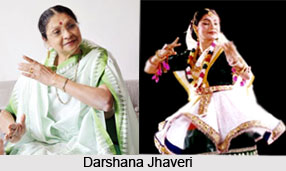 Darshana Jhaveri is an Indian classical dancer. She is the youngest of the four Jhaveri sisters. She showed her excellence in Manipuri dance from the year 1958.
Darshana Jhaveri is an Indian classical dancer. She is the youngest of the four Jhaveri sisters. She showed her excellence in Manipuri dance from the year 1958.
Early Life of Darshana Jhaveri
Darshana Jhaveri was born in the year 1940. She was the youngest of the four Jhaveri sisters. She was born and brought up in Mumbai in a Gujarati household. At the age of six, Darshana Jhaveri saw her elder sisters, Nayana and Ranjana, learn Manipuri dance from Guru Bipin Singh at their home. Soon she too started learning the dance form of Manipur, along with her sister Suverna. Later, Darshana Jhaveri learned the traditional Raslila dances from Sutradhari Kshetritombi Devi, the Nata Pung from Guru Meitei Tomba Singh and traditional Maibi Jagoi from Kumar Maibi.
Career of Darshana Jhaveri
Darshana Jhaveri is a foremost Indian proponent of Manipuri dance, an Indian classical dance form of North East India. Darshana Jhaveri is a disciple of Guru Bipin Singh, and started performing on stage in 1958 along with her sisters.
Darshana Jhaveri and Manipuri Nartanalaya
Darshana Jhaveri is one of the founders of the Manipuri Nartanalaya in the year 1972, which popularized Manipuri dance in India, and is currently headed by her, with centres at Mumbai, Kolkata and Imphal.
Darshana Jhaveri and her sisters
From the year 1950, the Jhaveri sisters, Nayana Jahveri, Ranjana Jhaveri, Suverna Jhaveri and Darshana Jhaveri had started performing together on stage all over India and abroad. In the year 1956, they were the first non-Manipuris to perform their dances at the Govindji Temple inside the royal palace of Imphal. Eventually the Jhaveri sisters established the Manipuri Nartanalaya with their Guru and Kalavati Devi in 1972, at Mumbai, Kolkata and Imphal, and in time their name became synonymous to Manipuri dance.
Darshana Jhaveri as a Writer
Darshana Jhaveri also has published several books and articles on the dance of Manipur and has assisted her guru during his lifetime, in teaching, research as well as in choreography, before taking herself.
Awards Received by Darshana Jhaveri
This exponent Manipuri Dancer, Darshana Jhaveri received the Sangeet Natak Akademi Award in the year 1996 by Sangeet Natak Akademi, India`s National Academy of Dance, Music and Drama. She was honoured with the Padma Shri Award by the Government of India in the year 2002.



















